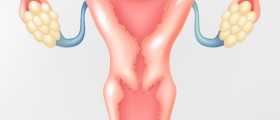
Ovarian cancer is the name for various types of cancers that can grow in the ovary. There are at least twenty various types of ovarian cancers. They are possibly deadly tumors which may progress in one or both ovaries. As a matter of course, cancerous tumors can be stromal cell tumors, germ cell tumors and epithelial cell tumors. Most ovarian cancers are of epithelial origin, 20% is germ tumor, and the rest are stromal tumors. During the first stages of ovarian cancers, there are no indicators. They grow almost silently. Before severe symptoms emerge, the ovarian cancer may have increased enough to scatter cancer cells through the abdomen. Ovarian cancers have a tendency to spread to intestine, diaphragm and omentum. In the United States, nearly 22 000 women are categorized with ovarian tumor annually. The major risk factors for ovarian cancer involve family history of ovarian, breast, or colorectal tumor, obesity, genetic mutations, age over 55, menopausal hormone therapy, delayed childbearing. Factors that can decrease the risk for ovarian tumor are hysterectomy and tubal ligation, pregnancy and oral contraceptive use. Up to 95% of women with ovarian cancer will live more than 5 years if their cancers are cured since they have effect beyond the ovaries.
There are three main forms of treatment: radiotherapy, chemotherapy and surgery. Surgery is very often needed to treat ovarian cancer. The type of the advised surgery will depend on the extent of the ovarian cancer and the woman's plan for having children. The procedure helps the doctor to precisely stage the tumor, establish a diagnosis, and do debulking (removal of as much tumor mass as possible). The surgeon makes an incision in the wall of the abdomen, and then he will insert a small device with camera into a pelvic cavity. This is called laparoscopy. When the cancer is diagnosed, the surgeon may suggest removing the uterus, both ovaries, fallopian tubes, lymph nodes or samples of tissue from the pelvis and abdomen.The first few days after the procedure are usually very painful. The painkillers can help. The patient usually spends several days in the hospital, but it may take several weeks before she return to normal activities. If the patient has not experienced menopause yet, the procedure may produce vaginal dryness, hot flashes, or night sweats. These signs are made by rapid loss of female hormones. According to the fact whether they are still remaining in the ovary or have scattered beyond the original place, there are four cancer stages. The survival rate depends on the cancer stage.

















Your thoughts on this
Loading...